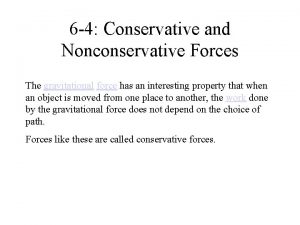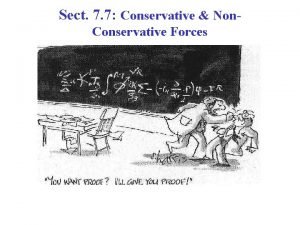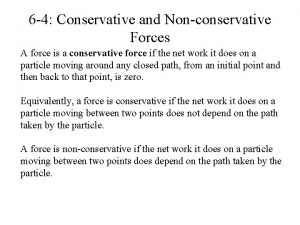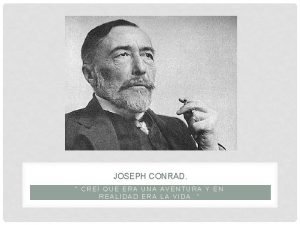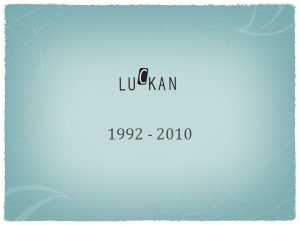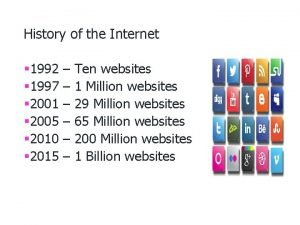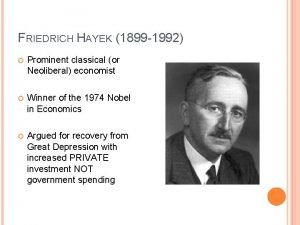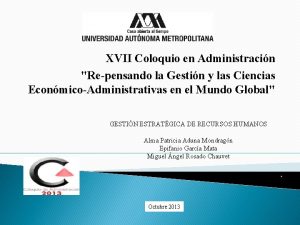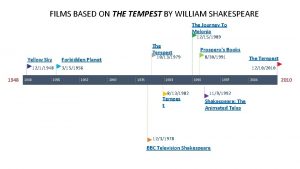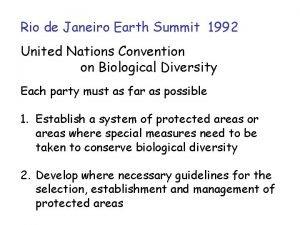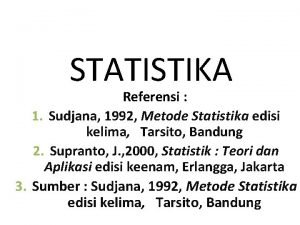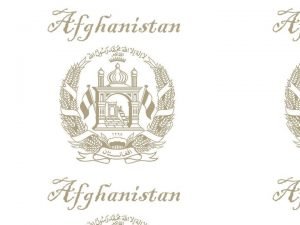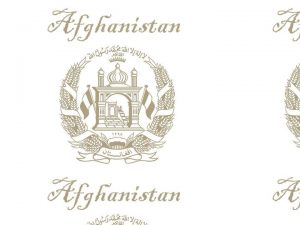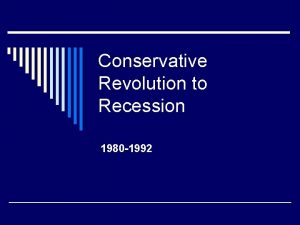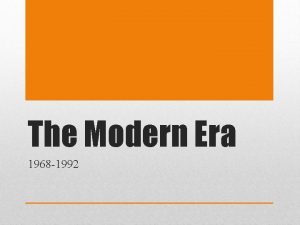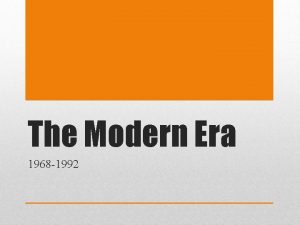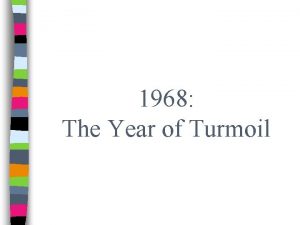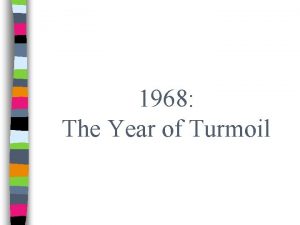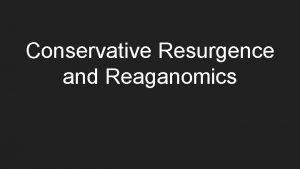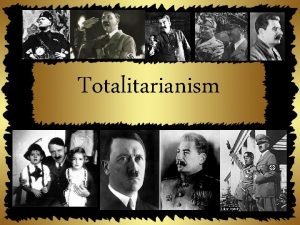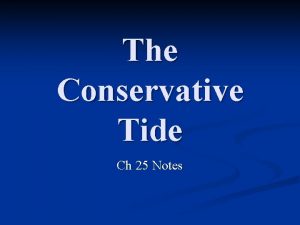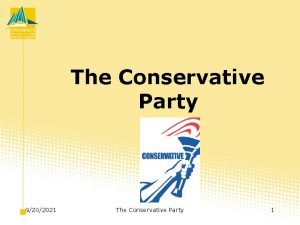The Modern Era 1968 1992 In 1968 conservative








































- Slides: 40

The Modern Era 1968 -1992


• In 1968 conservative Richard Nixon became President. • One of Nixon’s greatest accomplishments was his 1972 visit to communist China. • Visit opened China to American markets and highlighted a shift in American policy towards communism. Richard Nixon

• In 1972, Nixon ran for reelection. He was paranoid that he would lose the race. • Workers from his campaign were caught breaking in to the Democratic National Headquarters located in the Watergate complex in Washington, D. C. • They were looking to steal the Democrats’ “game plan” for the election. Watergate

• The Nixon administration attempted to cover-up to break in and distance themselves from the burglars. • A Congressional investigation ensued. • Nixon was found guilty of trying to cover-up the break-in after the discovery of taped interviews between him and his staff members at the White House. Watergate

• Due to mounting public pressure and a threat of impeachment, Nixon chose to resign from office. • Nixon officially announced his resignation in August 1974. • This make Richard Nixon the first and so far only President to ever voluntarily leave office. • The Watergate scandal caused many Americans to lose confidence and trust in a government they viewed as corrupt and untrustworthy. Nixon Resigns



• After Nixon resigned VP Gerald Ford became President. • Ford oversaw America during a time of severe economic recession. • Victim of two assassination attempts. • His reputation was further tarnished when he pardoned former President Nixon for any wrong doing in the Watergate scandal. Gerald Ford

• Two landmark decisions were handed down by the Supreme Court in the 1970’s. Supreme Court Decisions of the 1970’s

• In Roe v. Wade, the Supreme Court decided that women had the right to privacy in determining whether or not to have an abortion. • The health of the mother and “viability” of the child to survive outside the womb were taken into consideration in the decision Roe v. Wade (1973)

• Affirmative action – law set in place that allows race to be a deciding factor in college admission policies including specific quotas for each racial group • Allan Bakke applied to the University of California medical school but was rejected based on his “age” despite having high academic scores. • Bakke did more research and discovered that many minorities were admitted to the university with significantly lower test scores than Bakke. • Bakke took his case all the way to the Supreme Court and the court decided: • 1. to end the quota system used in college admissions • 2. endorsed affirmative action that gave equal opportunities for minorities, not special privileges Regents of the University of California v. Bakke (1978)


• In 1976 Georgia Democratic Governor Jimmy Carter beat Ford for the presidency. • Carter’s administration was heavily influenced by international issues. • One highlight was the Camp David Accords, a peace agreement between Egypt and Israel in 1978. • The Camp David Accords were the first signed peace agreement between the nations of the Middle East. Jimmy Carter



• Through much of the 20 th century, the Middle Eastern country of Iran had been an ally of the United States. • In 1979, Muslim leaders led a revolution that led to the overthrow of the Shah (king) of Iran while he was out of the country. • Revolutionaries wanted their nation to be ran by a strong, religious leader called the Ayatollah. Iranian Revolution



• In response to President Carter’s refusal to send the Shah back to Iran, Islamic revolutionaries stormed the US embassy in the Iranian capital of Tehran. • 52 Americans were held hostage for 444 days. • Hostages were finally released on January 20, 1981 when Carter left office and Ronald Reagan was sworn in. • Event only served to strengthen the anti-American sentiment in the Middle East. Iran Hostage Crisis



• Ronald Reagan, former governor of California elected President in 1980. • As a conservative, Reagan believed that the federal government should have a smaller role in American life. • Pursued an economic policy critics called “Reaganomics”; included tax breaks and budget cuts. • “Reaganomics” (sometimes referred to as supply-side economics or “trickle-down” economics) is generally thought to have benefitted wealthier Americans while penalizing the poor. Ronald Reagan





• During Reagan’s second term, a scandal involving the sale of weapons tarnished his administration. • In an attempt to free 7 American hostages from Iran, Reagan’s administration offered to sell Iran weapons for the hostage’s release. • This money would in turn be used to fund the rebellion of anti-Communist fighters (called “Contras”) in the Latin American country of Nicaragua. • Both the sale of arms to Iran and the funding of the Nicaraguan Contras violated acts of Congress. Iran-Contra Scandal


• One highlight of Reagan’s presidency is the fall of the communist Soviet Union. • Reagan is credited with pursuing a foreign policy of pressuring Soviet leaders to grant more individual freedoms to its citizens. • Reagan, while decreasing domestic spending, increased military spending. • Soviet leader Mikhail Gorbachev (right) instituted the policies of glasnost and perestroika that led to economic changes in the communist nation. Collapse of the Soviet Union

• Reagan famously encouraged Soviet leader Gorbachev to end Soviet control of its satellite nations. • “Mr. Gorbachev, tear down this wall!” • October 1989 – Berlin Wall torn down • Reunification of communist East Germany and capitalist West Germany Fall of the Berlin Wall

• On Christmas Day in 1991, Gorbachev resigns as leader of the Soviet Union. • The Soviet Union is dissolved into 15 individual republics including Russia, the Ukraine, Belarus and Kazakhstan. • The collapse signified the over 50 year standoff between the US and the Soviet Union known as the Cold War Comes to an End





• Reagan’s VP George H. W. Bush wins the presidency in 1988. • Remembered mostly for guiding the US through the Persian Gulf War (the 1 st Iraqi War). • August 1990 – Saddam Hussein and the Iraqi army invade neighboring Kuwait • US sends in troops to turn back the approaching Iraqi Army and liberate Kuwait. George H. W. Bush



 Gravitational force is conservative
Gravitational force is conservative Conservative force meaning
Conservative force meaning Force conservative et non conservative
Force conservative et non conservative Force conservative et non conservative
Force conservative et non conservative Creí que era una aventura y en realidad era la vida
Creí que era una aventura y en realidad era la vida Vi uma estrela tão alta
Vi uma estrela tão alta Era quiz: the baroque era
Era quiz: the baroque era Victorian and elizabethan era
Victorian and elizabethan era 2010-1992
2010-1992 Comrey & lee 1992
Comrey & lee 1992 Autoportrait robot arman
Autoportrait robot arman Jane pilkington 1992
Jane pilkington 1992 April 6 1992
April 6 1992 Ieee 519 1992
Ieee 519 1992 Recommendations of npe 1986
Recommendations of npe 1986 Basic food pyramid
Basic food pyramid Life skills oms 1992
Life skills oms 1992 Denis johnson, “emergency” (1992)
Denis johnson, “emergency” (1992) Power penelitian
Power penelitian Visual basic 1 of 1992.
Visual basic 1 of 1992. Internet 1992
Internet 1992 Rd 1435/1992
Rd 1435/1992 Friedrich hayek (1899-1992)
Friedrich hayek (1899-1992) Meltem hakarar
Meltem hakarar 1992 electoral map
1992 electoral map Modelo de bustillo (1994)
Modelo de bustillo (1994) Functions of rci
Functions of rci Situational crime prevention definition
Situational crime prevention definition Movie based on the tempest
Movie based on the tempest Program of action 1992
Program of action 1992 Reciprocity of attraction
Reciprocity of attraction History of linux
History of linux 1992 rio de janeiro
1992 rio de janeiro Metode statistika sudjana
Metode statistika sudjana Modern era music
Modern era music Postmodernism in literature
Postmodernism in literature Chabet is a follower of dadaism and cubism
Chabet is a follower of dadaism and cubism Conservative comparative and superlative
Conservative comparative and superlative Conservative mixing
Conservative mixing Why electric field is conservative
Why electric field is conservative Characteristics of perennialism
Characteristics of perennialism
